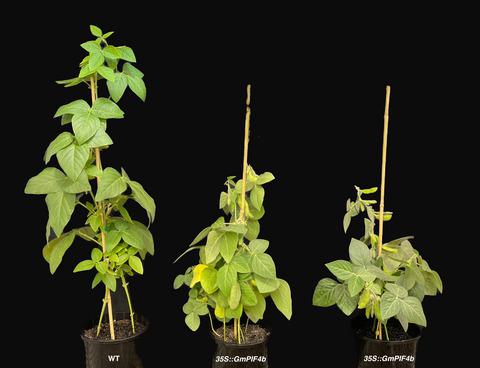当前位置:
X-MOL 学术
›
Food Energy Secur.
›
论文详情
Our official English website, www.x-mol.net, welcomes your
feedback! (Note: you will need to create a separate account there.)
Overexpression of PIF4 affects plant morphology and accelerates reproductive phase transitions in soybean
Food and Energy Security ( IF 4.0 ) Pub Date : 2021-05-07 , DOI: 10.1002/fes3.291 Hina Arya 1 , Mohan B. Singh 1 , Prem L. Bhalla 1
Food and Energy Security ( IF 4.0 ) Pub Date : 2021-05-07 , DOI: 10.1002/fes3.291 Hina Arya 1 , Mohan B. Singh 1 , Prem L. Bhalla 1
Affiliation

|
Phytochrome-interacting factor 4 acts as a signalling hub for integrating multiple environmental cues like light and temperature. While the function of PIF4 in the model plant Arabidopsis has been studied, there is limited knowledge regarding the role of PIF4 in agronomically important legume crop soybean. Here, we employed a constitutive overexpression approach to functionally characterise a soybean PIF4 homolog, GmPIF4b in a determinate short-day cultivar, Bragg. Multiple sequence alignment of seven soybean PIF4 homologs (GmPIF4a-g) with Arabidopsis PIF4 revealed the presence of an active phytochrome-binding (APB) domain in the N-terminal region of six soybean PIF4 homologs. Cis-elements related to plant hormone biosynthesis, stress response, meristem and endosperm gene expression were located in the promoter region of soybean PIF4s. Interestingly, transgenic soybean plants carrying 35s::GmPIF4b::polyA construct showed reduced plant height, reduced leaf surface area, decreased branching, early flowering and faster transition from full-bloom flowering stage to full maturity stage without any decline in yield. Further, pod colour of transgenic soybean plants changed to dark brown, whereas wild-type plants showed tan or light brown pod colour. Clear hilum was observed in seeds obtained from transgenic plants as opposed to the dark or black hilum of wild-type seeds. Transcripts of soybean florigens GmFT2a and GmFT5a were also elevated in transgenic plants. Collectively, our results suggest that GmPIF4b overexpression could affect phenotypes related to plant morphology and reproductive stages in soybean, and can be used as a gene target for soybean improvement programmes to ensure future food security.
中文翻译:

PIF4的过表达影响植物形态并加速大豆的生殖相变
光敏色素-相互作用因子 4充当信号枢纽,用于整合多种环境线索,如光和温度。虽然已经研究了PIF4在模式植物拟南芥中的功能,但关于PIF4在农艺学上重要的豆科作物大豆中的作用的知识有限。在这里,我们采用组成型过表达方法来功能表征大豆PIF4同系物GmPIF4b在确定的短日照品种 Bragg 中。七个大豆 PIF4 同源物 (GmPIF4a-g) 与拟南芥的多重序列比对PIF4 揭示了在六个大豆 PIF4 同系物的 N 末端区域中存在活性光敏色素结合 (APB) 域。与植物激素生物合成、胁迫反应、分生组织和胚乳基因表达相关的顺式元件位于大豆PIF4s的启动子区。有趣的是,携带35s::GmPIF4b::polyA 的转基因大豆植物构建体显示出植株高度降低、叶表面积减少、分枝减少、早花和从盛开开花阶段到完全成熟阶段的更快过渡,而产量没有任何下降。此外,转基因大豆植株的豆荚颜色变为深棕色,而野生型植株的豆荚颜色为棕褐色或浅棕色。在从转基因植物获得的种子中观察到透明的种脐,而不是野生型种子的深色或黑色种脐。转基因植物中大豆成花素GmFT2a和GmFT5a 的转录本也升高。总的来说,我们的结果表明GmPIF4b 过度表达可能会影响与大豆植物形态和生殖阶段相关的表型,并可用作大豆改良计划的基因靶标,以确保未来的粮食安全。
更新日期:2021-05-07
中文翻译:

PIF4的过表达影响植物形态并加速大豆的生殖相变
光敏色素-相互作用因子 4充当信号枢纽,用于整合多种环境线索,如光和温度。虽然已经研究了PIF4在模式植物拟南芥中的功能,但关于PIF4在农艺学上重要的豆科作物大豆中的作用的知识有限。在这里,我们采用组成型过表达方法来功能表征大豆PIF4同系物GmPIF4b在确定的短日照品种 Bragg 中。七个大豆 PIF4 同源物 (GmPIF4a-g) 与拟南芥的多重序列比对PIF4 揭示了在六个大豆 PIF4 同系物的 N 末端区域中存在活性光敏色素结合 (APB) 域。与植物激素生物合成、胁迫反应、分生组织和胚乳基因表达相关的顺式元件位于大豆PIF4s的启动子区。有趣的是,携带35s::GmPIF4b::polyA 的转基因大豆植物构建体显示出植株高度降低、叶表面积减少、分枝减少、早花和从盛开开花阶段到完全成熟阶段的更快过渡,而产量没有任何下降。此外,转基因大豆植株的豆荚颜色变为深棕色,而野生型植株的豆荚颜色为棕褐色或浅棕色。在从转基因植物获得的种子中观察到透明的种脐,而不是野生型种子的深色或黑色种脐。转基因植物中大豆成花素GmFT2a和GmFT5a 的转录本也升高。总的来说,我们的结果表明GmPIF4b 过度表达可能会影响与大豆植物形态和生殖阶段相关的表型,并可用作大豆改良计划的基因靶标,以确保未来的粮食安全。











































 京公网安备 11010802027423号
京公网安备 11010802027423号